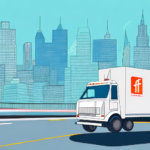How Much Should You Charge Per Mile for Delivery? A Guide to Calculating Rates
Setting delivery rates can be a daunting task for any business owner. Determining the appropriate per-mile charge to customers is a crucial decision that impacts both profitability and competitiveness. This guide provides a comprehensive overview of the key factors to consider when setting delivery rates, including analyzing expenses, competition, customer demands, and legal regulations.
Key Factors Influencing Delivery Rates
Before establishing your delivery rates, it's essential to evaluate various factors that can influence your pricing strategy:
- Competitive Pricing: Analyze your competitors' per-mile delivery charges to ensure your rates are competitive. Understanding the market standard helps in positioning your services effectively.
- Type of Service: Different services, such as same-day delivery or specialized handling for fragile items, may require different pricing structures.
- Distance and Location: Delivery rates can vary based on the distance traveled and the geographic location of your customers. Urban areas might have different cost implications compared to rural or remote locations.
- Delivery Vehicle: The type of vehicle used for deliveries affects fuel efficiency, operating costs, and maintenance expenses, all of which should be factored into your pricing.
- Operational Expenses: Consider both fixed and variable expenses, including fuel costs, wages, insurance, and vehicle maintenance, to ensure your rates cover all operational costs.
Impact of Delivery Time and Product Type
Delivery time and the nature of the product being delivered also play significant roles in determining delivery rates. Faster delivery services may command higher fees, while the delivery of perishable or fragile items may require additional handling and packaging, thereby increasing costs.
Understanding Delivery Costs: Fixed vs. Variable Expenses
Grasping the distinction between fixed and variable expenses is crucial for accurate pricing:
- Fixed Expenses: These remain constant regardless of the number of deliveries and include costs like rent, salaries, and insurance.
- Variable Expenses: These fluctuate based on delivery volume and include fuel costs, vehicle maintenance, and other operational expenses.
Effectively tracking these costs allows for precise rate calculations, ensuring that your pricing remains profitable. For more detailed information on operational expenses, refer to the Bureau of Labor Statistics.
Calculating Accurate Delivery Rates
Accurate cost calculations are essential for maintaining profitability and business sustainability:
Optimizing Delivery Routes
Regularly reviewing and optimizing your delivery routes can significantly reduce fuel costs and delivery times. Tools like GPS tracking and route optimization software can enhance efficiency. Consider using platforms such as GPS Insight for real-time tracking and route planning.
Incorporating Technology
Leveraging technology in your delivery operations can streamline rate calculations. Delivery management software automates the process by considering factors like distance, weight, and delivery speed, minimizing human error and enhancing accuracy.
Determining Your Optimal Rate Per Mile
To establish an optimal per-mile delivery rate, consider the following:
- Cost Analysis: Thoroughly analyze both fixed and variable expenses to understand the baseline cost per mile.
- Market Research: Study competitors' pricing and understand market demand to position your rates effectively.
- Customer Expectations: Align your rates with what customers are willing to pay while ensuring profitability.
Balancing profitability and affordability is key. Consulting with a financial expert can provide additional insights tailored to your business needs.
Adapting to Business Growth
Your optimal delivery rate per mile may evolve as your business grows. Regularly review and adjust your rates to reflect changes in expenses and market conditions, ensuring sustained profitability and competitiveness.
Strategies to Stay Competitive
Staying competitive in the delivery market requires proactive strategies:
Adjusting Rates Based on Market Trends
Monitor industry trends and adjust your pricing strategy accordingly. For instance, during peak seasons like holidays, increasing rates may be necessary to manage higher demand.
Offering Incentives and Promotions
Implementing promotions such as free shipping for orders above a certain amount can attract more customers. Additionally, partnering with other businesses to offer bundled shipping discounts can expand your market reach.
Collaborating with Other Businesses
Collaborations can lead to mutually beneficial arrangements, such as shared delivery routes or bulk shipping discounts, optimizing delivery rates and increasing revenue.
Effective Communication of Delivery Rates
Transparent and effective communication of delivery rates enhances customer trust and satisfaction:
Transparency in Pricing
Clearly display your delivery rates on your website and marketing materials. Avoid hidden fees to maintain a positive brand image.
Leveraging Digital Communication Channels
Use email and text message notifications to inform customers about delivery rates and any associated costs in real-time. This approach keeps customers informed and reduces confusion.
Regularly Updating Rates
Regularly review and update your delivery rates to remain competitive. Conduct market research to ensure your rates align with industry standards and inform customers of any changes in advance.
Pricing Models: Flat Rate vs. Distance-Based
Choosing the right pricing model is crucial for meeting customer expectations and maintaining profitability:
- Flat Rate Pricing: Offers simplicity and predictability, making it easier for customers to understand costs. However, it may not account for variations in delivery requirements.
- Distance-Based Pricing: Provides a more tailored approach, charging customers based on the actual distance traveled. This model can be fairer but may be more complex to communicate.
Evaluate the pros and cons of each model to determine which aligns best with your business objectives and customer preferences.
Legal and Regulatory Considerations
Compliance with local and state regulations is essential when setting delivery rates:
- Minimum Wage Laws: Ensure your delivery rates cover employee wages in accordance with labor laws.
- Insurance Requirements: Maintain appropriate insurance coverage to protect your business and customers.
- State-Specific Regulations: Be aware of any state-specific regulations, such as caps on delivery service charges.
Consulting with a local business attorney or your chamber of commerce can provide clarity on the legalities involved in your specific location.
Utilizing Technology for Rate Calculations
Integrating technology can enhance the accuracy and efficiency of your delivery rate calculations:
Delivery Management Software
Implementing delivery management software automates rate calculations by considering various factors like distance, weight, and speed. This reduces manual errors and saves time. Solutions like Route4Me offer comprehensive delivery management features.
Real-Time Tracking
Real-time tracking not only improves customer experience by providing accurate delivery status but also allows you to monitor and adjust rates based on actual delivery performance.
Analyzing Customer Feedback to Refine Pricing
Customer feedback is invaluable for refining your pricing strategy:
- Conduct surveys to gauge customer satisfaction with delivery rates.
- Monitor social media and review platforms for insights into customer perceptions.
- Adjust your pricing strategy based on constructive feedback to better meet customer expectations.
Conclusion
Setting the right delivery rates per mile requires a careful balance of cost analysis, market research, and strategic planning. By considering factors such as operational expenses, competitive pricing, and customer demands, you can establish rates that are both profitable and attractive to customers. Incorporating technology, staying compliant with regulations, and continuously refining your pricing strategy based on feedback and industry trends will ensure your delivery business remains competitive and sustainable in the long run.




















